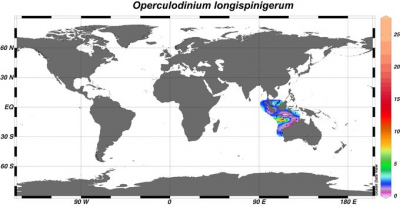Page path:
- Modern Dinocyst Key
- transparent cysts
- randomly distributed processes
- transparant cyst with solid processes
- Operculodinium longispinigerum
Operculodinium longispinigerum
Zonneveld, K.A.F. and Pospelova V. (2015). A determination key for modern dinoflagellate cysts. Palynology 39 (3), 387- 407.
Field characteristics
Operculodinium longispinigerum Matsuoka 1983
Field characteristics:
Chorate spaherical cyst with smooth to finely granular surface. The nontabular processes are relatively long, solid and slender, with their distal extremities acuminate or occasionally bifid. Tabulation is only indicated by a precingular archeopyle (type P).
Dimensions: Cyst body diameter: 29 to 40 µm; length of processes: 7 to 14 µm.
Motile affinity: Unknown.
Stratigraphic range: Late Miocene to Recent.
Comparison with other species:
Operculodinium longispinigerum is closely similar to O. centrocarpum and Pentapharsodinium dalei and it is very hard to distinguish these species from each other due to the variation in process morphology. The differentiating criteria are the number of processes which are less in O. longispinigerum and the processes of O. longispinigerum which are solid and clearly acuminate or bifurcate. It differes from Pentapharsodinium dalei in having less processes that are never branched.
Field characteristics:
Chorate spaherical cyst with smooth to finely granular surface. The nontabular processes are relatively long, solid and slender, with their distal extremities acuminate or occasionally bifid. Tabulation is only indicated by a precingular archeopyle (type P).
Dimensions: Cyst body diameter: 29 to 40 µm; length of processes: 7 to 14 µm.
Motile affinity: Unknown.
Stratigraphic range: Late Miocene to Recent.
Comparison with other species:
Operculodinium longispinigerum is closely similar to O. centrocarpum and Pentapharsodinium dalei and it is very hard to distinguish these species from each other due to the variation in process morphology. The differentiating criteria are the number of processes which are less in O. longispinigerum and the processes of O. longispinigerum which are solid and clearly acuminate or bifurcate. It differes from Pentapharsodinium dalei in having less processes that are never branched.
Geographic distribution
Geographic distribution based on :
Zonneveld et al., 2013. Atlas of modern dinoflagellate cyst distribution based on 2405 datapoints. Review of Palaeobotany and Palynology, v. 191, 1-197
Zonneveld et al., 2013. Atlas of modern dinoflagellate cyst distribution based on 2405 datapoints. Review of Palaeobotany and Palynology, v. 191, 1-197
Operculodinium longispinigerum occurs in tropical to equatorial, full-marine, oligotrophic environments with well ventilated bottom waters.

Distribution:
Operculodinium longispinigerum occurs in tropical to equatorial regions of the eastern equatorial Indian Ocean and adjacent seas. Highest abundances (up to 22.7%) occur south of the Indonesian island Java.
Environmental parameters:
SST: 20.6 - 29.8°C (winter - spring). SSS: 31.6 - 35.7 (summer - summer), [P]: 0.09 - 0.36 μmol/l, [N]: 0.23 - 0.68 μmol/l, chlorophyll-a: 0.11 - 0.39 ml/l, bottom water [O2]: 2.2 - 4.6 ml/l.
The distribution of O. longispinigerum is restricted to full-marine oligotrophic environments with well ventilated bottom waters.
Comparison with other records:
So far O. longispinigerum has not been recorded from other regions than those recorded in this Atlas. However, the species has been described from Late Cainozoic sediments of the Niigata district in central Japan suggesting that it could have a wider distribution than as documented in this Atlas.
Operculodinium longispinigerum occurs in tropical to equatorial regions of the eastern equatorial Indian Ocean and adjacent seas. Highest abundances (up to 22.7%) occur south of the Indonesian island Java.
Environmental parameters:
SST: 20.6 - 29.8°C (winter - spring). SSS: 31.6 - 35.7 (summer - summer), [P]: 0.09 - 0.36 μmol/l, [N]: 0.23 - 0.68 μmol/l, chlorophyll-a: 0.11 - 0.39 ml/l, bottom water [O2]: 2.2 - 4.6 ml/l.
The distribution of O. longispinigerum is restricted to full-marine oligotrophic environments with well ventilated bottom waters.
Comparison with other records:
So far O. longispinigerum has not been recorded from other regions than those recorded in this Atlas. However, the species has been described from Late Cainozoic sediments of the Niigata district in central Japan suggesting that it could have a wider distribution than as documented in this Atlas.


